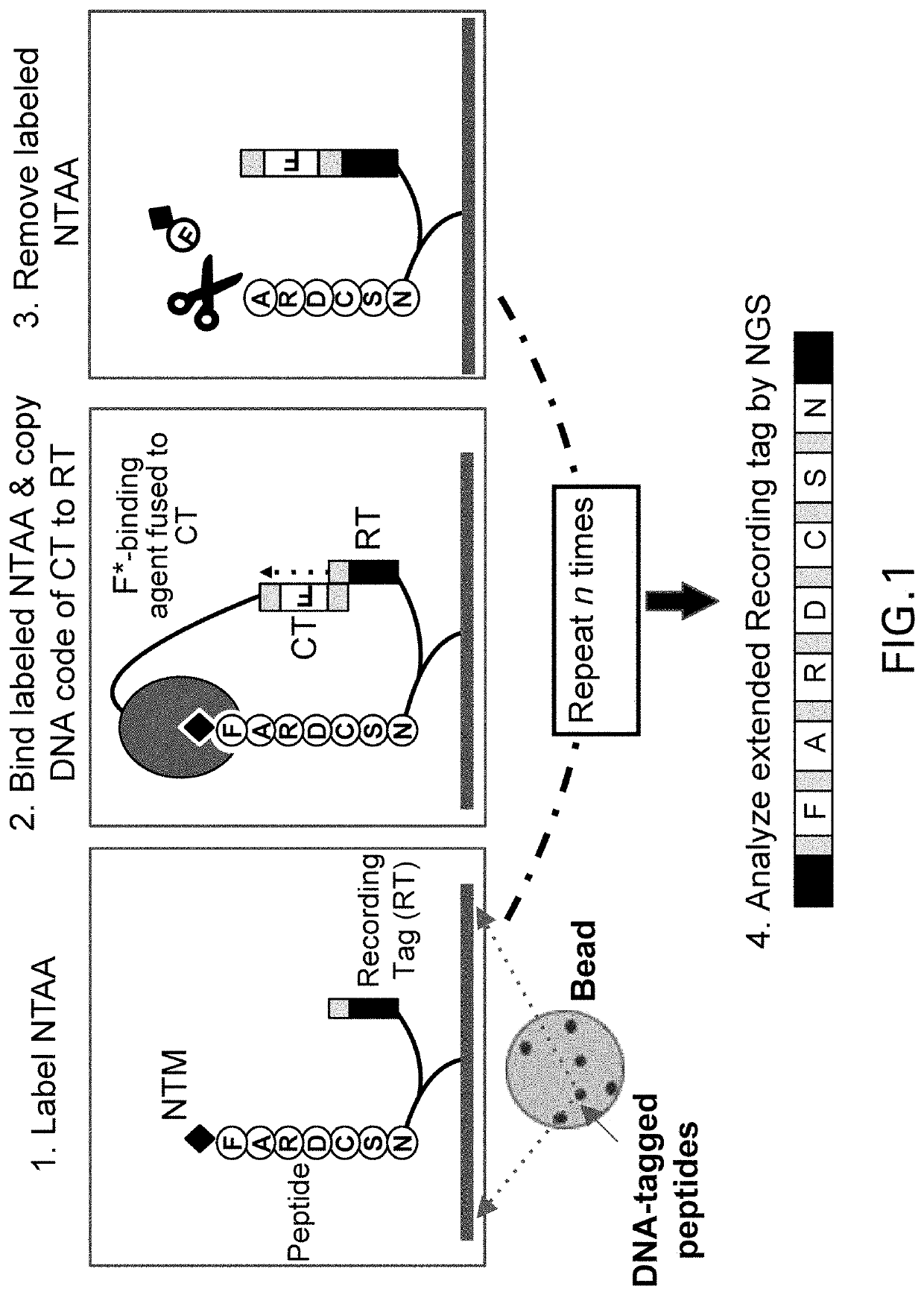Metalloenzymes for biomolecular recognition of n-terminal modified peptides
- Summary
- Abstract
- Description
- Claims
- Application Information
AI Technical Summary
Benefits of technology
Problems solved by technology
Method used
Image
Examples
example 1
ing Human Carbonic Anhydrase 2 (CA II) as Model Metalloprotein Binder for Modified Peptides
[0388]Carbonic anhydrase is well known as one of the most efficient enzymes in nature (nearly diffusion limited). This zinc binding protein is expressed in nearly all forms of life, with numerous variants / isozymes that are distinct in protein sequence and structure, depending on the species of origin. The active site zinc ion is catalytic for the conversion of carbon dioxide and water to bicarbonate and is bound at the bottom of the 15 Å deep substrate binding pocket (for human carbonic anhydrase 2, SEQ ID NO: 7) characterized by hydrophobic walls and a hydrophilic cleft. Carbonic anhydrases have been pursued as drug targets for multiple indications, and numerous metal binding small molecule inhibitors have been identified along with corresponding crystal structures and SAR. Carbonic anhydrase is a small (˜30 kD) monomeric protein (although some variants form dimers) with no appreciable post-t...
example 2
and Design of Engineered Metalloprotein Binders Suitable for a Protein Binding (Such as NGPS) Assay and Capable of Binding NTM-P1 with Minimal P2 Bias
[0390]Part I. Initial binder selection. To identify metalloproteins with potential utility as binders for the NGPS assay, zinc binding proteins with available crystal structures were reviewed from the literature in the Research Collaboratory for Structural Bioinformatics (RCSB) Protein Data Bank (PDB), and those with at least one accessible zinc ion, also referred to as Zn(II), binding site were identified as candidates for computational modeling studies. Accessible Zn(II) binding sites were defined as having trivalent Zn(II) coordination in PDB accession codes (also referred to as PDB IDs), in order to permit NTM-peptide coordination in the fourth Zn(II) coordination site, and binding pockets with either a conical or groove-shaped architecture near the Zn(II) binding site. Where Zn(II) binding sites had tetravalent Zn(II) coordination...
example 3
Origin, Synthesis and Installation of NTMs on NTAA Residues of Peptides
[0431]Structures, origin and installation methods for exemplary N-terminal modifier agents used for modification of NTAA residues of peptides are shown below.
[0432]N-terminal modifier agent for M=M64 (in the ester form).
[0433]Exemplary method of installing M64 onto N-terminal amino acid of a peptide, shown as NTAA-PP. Peptides, in solution or on solid-support, were dissolved in 25 uL of 0.4 M MOPS buffer, pH=7.6 and 25 uL of acetonitrile (ACN). Separately, the active ester reagent was prepared from M64 and dissolved in 25 uL DMA and 25 uL ACN to a concentration of 0.05 M stock solution. Then, 50 uL of the active ester stock solution was added to the peptide-ACN:MOPS solution and incubated at 65° C. for 60 minutes. Upon completion, the peptides were functionalized with the respective modification as shown in the above schemes.
[0434]Alternatively, a surfactant-aqueous coupled system can be employed to install NTM (...
PUM
| Property | Measurement | Unit |
|---|---|---|
| Fraction | aaaaa | aaaaa |
| Molar density | aaaaa | aaaaa |
| Dissociation constant | aaaaa | aaaaa |
Abstract
Description
Claims
Application Information
 Login to view more
Login to view more - R&D Engineer
- R&D Manager
- IP Professional
- Industry Leading Data Capabilities
- Powerful AI technology
- Patent DNA Extraction
Browse by: Latest US Patents, China's latest patents, Technical Efficacy Thesaurus, Application Domain, Technology Topic.
© 2024 PatSnap. All rights reserved.Legal|Privacy policy|Modern Slavery Act Transparency Statement|Sitemap



